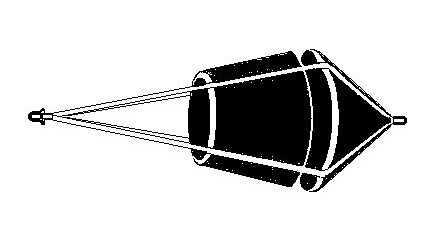D/C-6
Catamaran, Prout
37' x 16' x 7.5 Tons
Seabrake GP-24
Force 7 Condition
File D/C-6, obtained from Robert Harnwell, Berwyn, PA. - Vessel name Malaika, hailing port Philadelphia, Snowgoose catamaran designed by the Prout brothers, LOA 37' x Beam 16' x Draft 2.8' x 7.5 Tons - Drogue: Seabrake GP-24 (24" diameter) on 100' x 5/8" nylon three strand tether - No bridle - Deployed in a gale in deep water about 200 miles WNW of Cape Finisterre (Spain) with winds of 30 knots and seas of 12-20 ft. - Vessel's stern yawed 10° - Speed was reduced to 4-5 knots during 48 hours of deployment.

Malaika was sailed from England to the Chesapeake Bay in August 1995. Like most Prout catamarans her mast is stepped aft. With her center of effort so far back she has a slight tendency to want to round up into the wind, and will yaw slightly more than other catamarans when running downwind. Taking the main down and using headsails will reduce this the yawing - and the weather helm. So will towing a speed-limiting drogue. This applies to any vessel with a mast stepped aft or a center of effort well back - schooners, for example. Transcript:
Deployed the drogue a number of times across the Atlantic. From England to the Azores the wind was straight behind. In the gale she was surfing 10-12 knots down the big ones, slewing around at the bottom. In a big, heavy boat like ours that's really fast. Deployed the drogue and it slowed the boat down to about 5 knots - like putting on the brakes. At one point had to roll out more jib to keep up speed and control the boat. We had a sail up throughout the 48 hours with the drogue. Most of the time she would track straight, slewing around only at the bottom of the waves.
No bridle, primarily because the boat is equipped with a real heavy duty cleat and roller for the stern anchor, slightly off the centerline of the boat, about 3 feet off the centerline. No noticeable difference. The wind was knocking us around and you really couldn't tell that the cleat wasn't on the centerline of the boat. Steered by hand through the worst of it. The autopilot in most cases could do a better job steering than we could, but there were times when you would get a succession of waves, of one, two, and three waves, and on the third one you knew that you had to get on the helm yourself, because you could feel that the boat was going too fast and you were going to lose control at the bottom of the wave - when you came off the bottom of the wave the autopilot wasn't going to be able to keep the boat straight so you had to take over. But she didn't yaw about significantly in those conditions. A couple of times things got thrown around down below, but that was about it.
Due to higher speeds on catamarans, use caution in deploying a drogue. We almost lost control of it when we first put it overboard. It took off so fast and it had so much drag that it almost overwhelmed both of us. My suggestion would be to practice deploying it beforehand, which is what we really should have done. We lost the polypropylene trip line due to a slipped knot and had to pull the drogue back in with a winch - it's like having a bulldog pulling against you at the other end.
[Positioning the drogue:] The drogue grabbed anywhere it was off the stern. Sometimes it would come out of the front face of a wave, so I guess the farther back you position it the better off you are. Given the moderate conditions [30-knot winds] we didn't want it much more than a 100 feet off the stern, worrying about having to haul it back again. It would have worked fine 25 feet off the stern, but at a 100 feet everything was a little more stable. You need to use good chafing gear. We had the rode running through an anchor roller. Even with the roller and the nice, smooth metal surfaces, I had to let out a little line every twenty minutes or so.